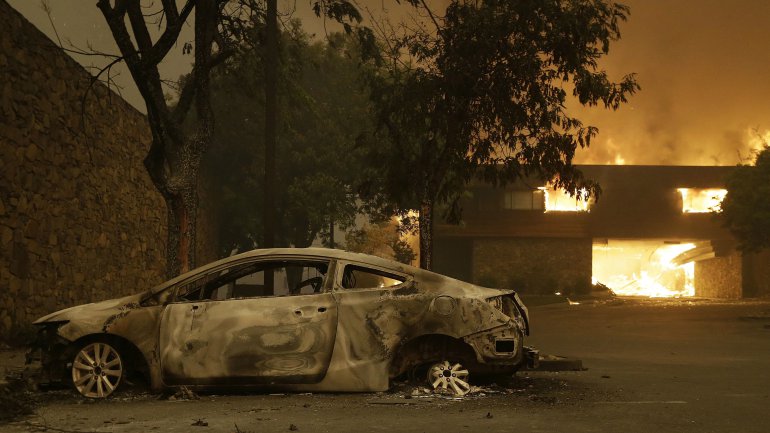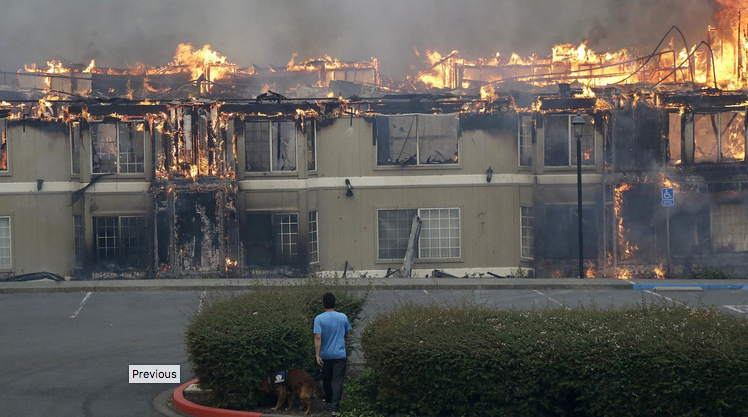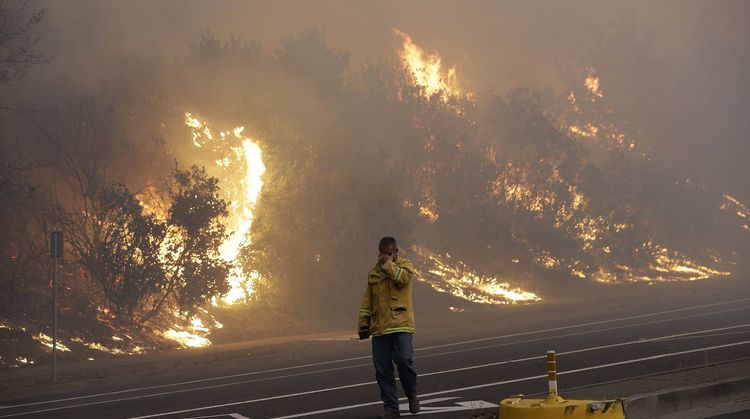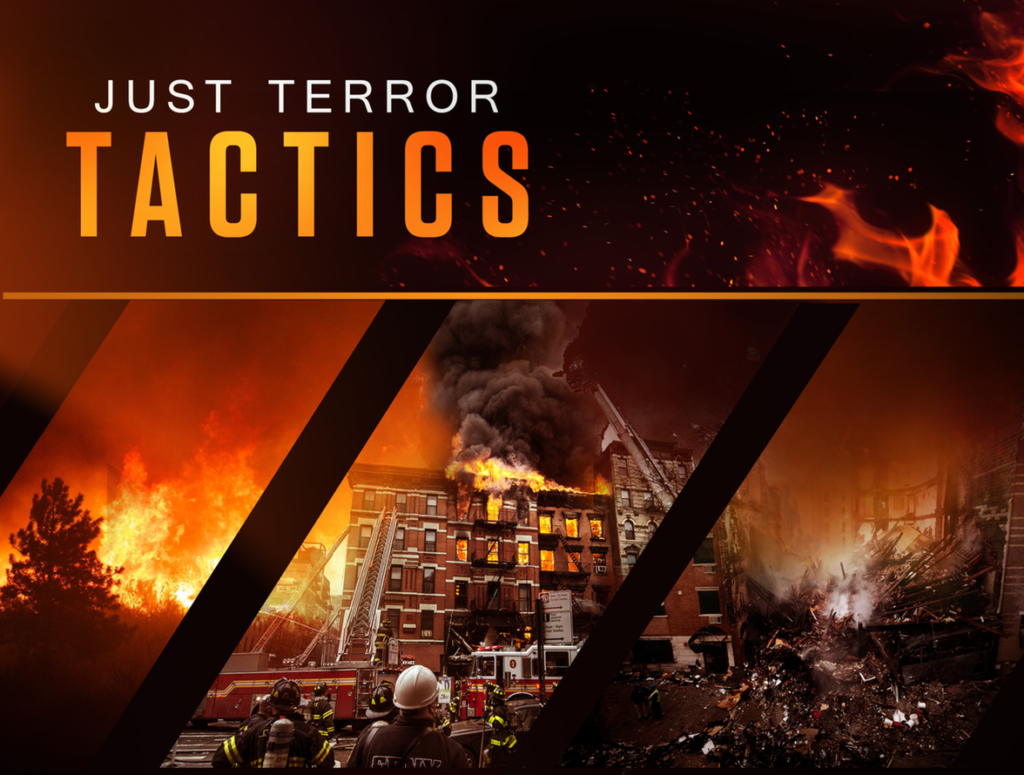By Bridget Johnson
The menacing orange glow that illuminated a Halloween-decorated Disneyland this week was a villain known all too well to Californians: wildfire season, when a dry summer and toasty temps have left hillsides of crispy fuel prime for a single spark of flame to hungrily consume, driven at a  maddening pace by gusty winds. Red-flag warnings of high fire danger inevitably are bumped on the evening news by live coverage of residents fleeing conflagrations that seemed to come out of nowhere, and people far away from the fire danger find fine ash raining on their cars.
maddening pace by gusty winds. Red-flag warnings of high fire danger inevitably are bumped on the evening news by live coverage of residents fleeing conflagrations that seemed to come out of nowhere, and people far away from the fire danger find fine ash raining on their cars.
With continually evolving numbers, CAL FIRE reported on 11 Oct. that 22 large wildfires had burned more than 170,000 acres, destroying at least 3,500 homes and commercial structures and killing at least 21 people – numbers that will remain fluid until the flames abate and authorities can locate the missing and assess property damage. Wind gusts that can reach up to hurricane force and low humidity returned to Northern California as well, not only hurting firefighters’ ability to get a handle on the existing blazes but raising the potential for even more fires. Power and cell phone communications are down in many affected areas.
“This event may end up as one of the costliest wildfire events since our analysis began in 1980,” declared Adam Smith, a researcher at the National Oceanic and Atmospheric Administration. Standard home and business insurance policies cover wildfire damage same as other fire coverage, including outbuildings. Officials are on guard for looting, another potential cause of loss, in evacuated areas.
The blazes are also creating environmental hazards far beyond the burn area. The Bay Area Air Quality Management District issued health and smoke advisories as fires ripped through wine country, advising residents to try to block out smoke by recirculating air and relocate to cooling centers if needed. “Very unhealthy air quality from the wildfires in the North Bay is causing unprecedented levels of air pollution throughout the Bay Area. Due to active wildfires and changing wind patterns, air quality could be impacted for many days to come,” warned the health advisory. “Outside of the active fire areas, air quality will be variable and unpredictable. Air quality may improve at times or get worse, very quickly.” Another health hazard in the immediate fire zones: hospitals in danger having to move patients and close their doors.
Air Quality Management District issued health and smoke advisories as fires ripped through wine country, advising residents to try to block out smoke by recirculating air and relocate to cooling centers if needed. “Very unhealthy air quality from the wildfires in the North Bay is causing unprecedented levels of air pollution throughout the Bay Area. Due to active wildfires and changing wind patterns, air quality could be impacted for many days to come,” warned the health advisory. “Outside of the active fire areas, air quality will be variable and unpredictable. Air quality may improve at times or get worse, very quickly.” Another health hazard in the immediate fire zones: hospitals in danger having to move patients and close their doors.
Property protection against wildfires is as drummed into the California home or business owner psyche as retrofitting for earthquakes. Particularly as suburbs sprawl higher and higher into the hills, ignition-resistant construction, 30 feet of brush clearance and 100 feet of defensible space around structures, clear access for firefighting vehicles, clean gutters and tree trimming, fire-resistant landscaping and other preventive measures help give firefighters an edge. As residents north of Santa Rosa, Calif., can attest, though, depending on the conditions the best individual prevention isn’t foolproof: flames quickly ripped through tract homes and businesses including restaurants, hotels and a shopping center, jumping Highway 101.
California has a fine-tuned wildfire-fighting infrastructure, including a 747 SuperTanker kept near Sacramento that can drop up 19,600 gallons of retardant on flames in a single pass. But there  will be situations when containment is, for the moment, impossible. Crews and resources may be overtaxed by numerous blazes in different locations. Fire behavior can surprise even the most veteran engineers.
will be situations when containment is, for the moment, impossible. Crews and resources may be overtaxed by numerous blazes in different locations. Fire behavior can surprise even the most veteran engineers.
The old Smokey the Bear campaign – “Only you can prevent forest fires” – strikes at the heart of authorities’ fire prevention problem: regardless of how much clearance or wildfire prevention education is done in advance there will be ultimately be a negligent person who picks the wrong day to burn leaves or the wrong spot for a campfire, or a criminal intent on seeing fire rip through wildlands and neighborhoods. Upwards of 90 percent of wildfires are caused by humans (that’s up to 95 percent in California); natural causes comprising the remaining 10 percent include lightning and lava. Three-quarters of arsons are set outdoors, not including vehicle fires. Last month, a 15-year-old Vancouver boy was suspected of throwing a smoke bomb that ignited the  massive Eagle Creek fire in Oregon.
massive Eagle Creek fire in Oregon.
Though common causes range from tossed cigarettes to lawn-mower sparks, the possibility exists for extremist groups to take advantage of tinder-dry conditions. Terror groups have encouraged arson among a menu of terror tactics, although what they’ve envisioned hasn’t yet been put into practice. In the January 2017 issue of their Rumiyah magazine, Daesh extensively wrote on how lone jihadists could use arson, listing among many potential targets “forest areas adjacent to residential areas.”
In a 2012 issue of Inspire magazine, al-Qaeda gave instructions for sparking wildfires – the more remote, the better. “In America, there are more houses built in the [countryside] than in the cities,” the magazine stated. “It is difficult to choose a better place [than] in the valleys of Montana.”

Arson easily achieves terrorists’ goals of spreading fear and uncertainty, inflicting “crusader” deaths and causing widespread economic destruction and disruption. When aided by Mother Nature’s accelerants and drought-parched fuel, the method also arouses little suspicion as operatives’ only needed weapon is flame.
Investigators in the California wildfires initially suspected humans are behind the blazes, whether unintentional or intentional, given how the three largest fires in Napa, Solano and Mendocino counties all began between 9 p.m. and 11 p.m. on 8 Oct. near populated areas. “They burned so quickly. There was no time to notify anybody,” Ken Pimlott, director of the California Department of Forestry and Fire Protection, told reporters. “These fires came down into neighborhoods before anybody realized the fires were occurring in many cases.”
Gate 15 provides intelligence and threat information to inform routine situational awareness, preparedness planning, and to penetrate the decision-making cycle to help inform time-sensitive decisions effecting operations, security, and resources. We provide clients with routine cyber and physical security products tailored to the individual client’s interests. Such products include relevant analysis, assessments, and mitigation strategies on a variety of topics.
 Bridget Johnson is a Senior Risk Analyst with Gate 15 and a veteran journalist whose news articles and analyses have run in dozens of news outlets across the globe. Bridget first came to Washington to be online editor at The Hill, where she wrote The World from The Hill column on foreign policy. Previously she was an opinion writer and editorial board member at the Rocky Mountain News and nation/world news columnist at the Los Angeles Daily News.
Bridget Johnson is a Senior Risk Analyst with Gate 15 and a veteran journalist whose news articles and analyses have run in dozens of news outlets across the globe. Bridget first came to Washington to be online editor at The Hill, where she wrote The World from The Hill column on foreign policy. Previously she was an opinion writer and editorial board member at the Rocky Mountain News and nation/world news columnist at the Los Angeles Daily News.
Bridget is a Senior Fellow specializing in terrorism analysis at the Haym Salomon Center. She is an NPR contributor and has contributed to USA Today, The Wall Street Journal, National Review Online, Politico, New York Daily News, The Jerusalem Post, The Hill, New York Observer, Washington Times, RealClearWorld and more, and has myriad television and radio credits. Bridget is Washington Bureau Chief for PJ Media. Follow Bridget on Twitter: @Bridget_PJM
The images used in this post were taken from the Fox 43 @fox43 photo gallery, “California fires: Searchers seek hundreds of missing,” 12 Oct 2017, http://fox43.com/2017/10/12/california-fires-searchers-seek-hundreds-of-missing/
Terror propaganda images taken from the terror publications noted above. A potentially criminal offense in the UK… :/
